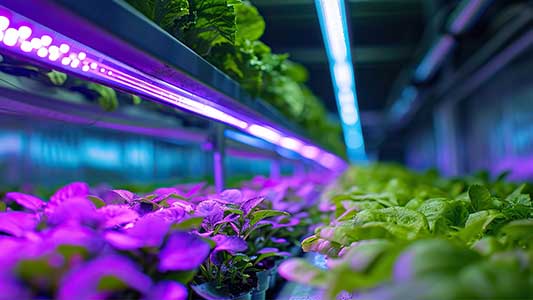Horticulture lighting uses artificial light to supplement natural sunlight and promote plant growth. This technology is essential for greenhouses, vertical farming, and indoor farming, allowing for annual crop cultivation. Horticulture lighting systems utilize various light sources, such as High-Pressure Sodium (HPS) lamps, fluorescent lights, and LEDs (Light Emitting Diodes), to deliver the specific wavelengths of light required for plant development and photosynthesis. It allows for continuous production by supplementing or replacing natural light, making it independent of seasonal changes or geographic limitations.
As per the research by Allied Market Research, the global horticulture lighting market is projected to witness promising growth with 20.3% CAGR by 2032. The industry is gaining popularity due to a surge in demand for fresh produce. The rising trend of urbanization and growing awareness regarding food security has led to an increased desire for high-quality, locally sourced vegetables, herbs, and fruits. Horticulture lighting addresses this demand by facilitating annual cultivation in controlled environments like vertical farms and greenhouses. This technology enables growers to cultivate crops independent of external conditions, ensuring a steady and reliable fresh produce supply.
Innovations driving efficiency in horticulture lighting
Horticulture Lighting has experienced significant transformation due to technological advancements and an increasing emphasis on sustainable agricultural practices. As farmers want to optimize cultivation conditions, horticulture lighting has become an essential tool. The latest LED horticulture lights are energy-efficient, offering more effective illumination and consuming less power compared to conventional lighting systems. Human Centric Lighting (HCL) is one of the rising phenomena in the industry. It recognizes how light affects plants and the people cultivating them. HCL involves fine-tuning light spectra to boost the productivity and health of both plants and growers.
Moreover, smart control systems are increasingly essential in horticulture lighting operations. These systems allow growers to precisely control and automate lighting parameters like duration, spectrum, and intensity. The incorporation of data analytics and sensors further improves the flexibility of lighting systems to environmental conditions. This trend aligns with the broader adoption of precision agriculture, enabling users to make well informed decisions for more sustainable and efficient crop production.
Controlled Environment Agriculture (CEA) and vertical farming are influencing horticulture lighting trends. In vertical farming, artificial lighting is essential for plant growth in stacked layers. LED lighting, known for its customizable spectra and compact design, is ideal for vertical farming setups. This shift is revolutionizing urban agriculture, allowing year-round cultivation in controlled parameters.
Role of strategic alliances in fueling horticulture lighting innovation
Technology is essential for the leading horticulture lighting companies to maintain their dominance, achieved through innovating products, forming strategic partnerships, and investing in research and development. Ongoing advancements in LED technology are fueling innovation and establishing LEDs as the favored option for horticulture lighting solutions. This enables top companies to maintain their dominance by offering cutting-edge products. For instance, in November 2023, Acuity Brands revealed its plans to acquire Arize horticultural lighting products from Current Lighting Solutions, LLC. Additionally, the company announced plans to maintain a distribution partnership with Hort Americas, for the sales and support of Arize products in North America.
On the other hand, Sollum Technologies, known for fully dynamic LED grow lights development, initiated an innovative research program in September 2023. Sollum Empowering Academic Researchers in CEA and Horticulture (S.E.A.R.C.H), the program facilitated researchers and institutions in achieving significant advancements in horticultural lighting knowledge and practices. Participants utilized Sollum’s innovative LED grow light solution to conduct their research.
To conclude, the rapid evolution of horticulture lighting, propelled by advancements like energy-efficient LED technology and smart control systems, is revolutionizing agricultural practices. LED technology and smart control systems are advancing the horticulture lighting industry, enabling efficient and sustainable crop cultivation to meet global agricultural demands.
For a detailed analysis of the global horticulture lighting industry with regional analysis, contact our experts today!
Short description
Horticulture lighting uses artificial light to supplement natural sunlight and promote plant growth. It is revolutionizing modern agriculture by enabling efficient, high-quality, and sustainable crop production across various environments. LED technology and smart control systems are advancing the horticulture lighting industry, enabling efficient and sustainable crop cultivation to meet global agricultural demands.














